Ashley Smith
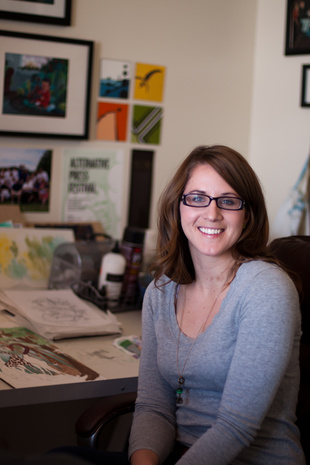
I noticed that on your website you say “#1 illustrator recommended by gypsies, and a close #2 by pirates.” I’m curious—how does one become recommended by gypsies and pirates?
It is a very draining and difficult process involving intensive creative and physical tests. Normally the code of silence should never be broken regarding the details of said tests, but because I passed them with such high marks and have given back to the gypsy and pirating communities through portraiture and ransom notes, I feel I can be a tad more open about it. Let’s just say it calls for pillaging, plundering, and drinking lots of rum. Although they let me off on the rum bit, seeing as I was Mormon and all.
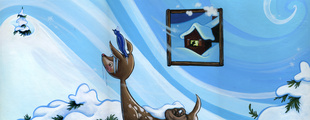
Is there a particular piece that you consider your personal best? Why?
Usually I consider the very last piece I have done as a personal best because it carries an accumulation of all I have learned and struggled through in its structure and core. If I don’t get that feeling, it’s probably because I didn’t put enough of myself in the piece or work hard enough to attain the best I am capable of.
But looking back, a few pieces are more meaningful than others—like the fireflies piece or the one with the girl looking to the sky with stars in the shape of the Star of David.
That last one was a book cover idea for my favorite book as a kid, Number the Stars, which became a very meaningful book to me. It’s very lyrical and calm while also portraying a sense of innocence.
The fireflies piece captured the essence of childhood and the imagination that always abounded inside of me when I was a kid. Fireflies are wonderfully whimsical.
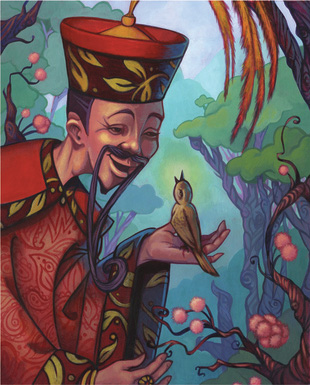
In your illustrations you seem drawn towards creating vibrant pieces with heavy outlines around most of the objects. What do you like best about creating and designing in this style?
I am obsessed with color. I love the way that hue, temperature, and intensity of any pigment can change dramatically just by placing it beside another color. I am enraptured by the outcome of combining warm and cool hues in artwork and what it does to your brain and your emotions. Somehow the contrast can create this amazing harmony that all humans relate to. Opposition in all things, I suppose.
Most of my work is just furthering the experiment with color that is constantly playing out in my brain and transferring my thoughts or conclusions on the matter to paper. I think some of the strongest emotions, learning opportunities, and knowledge I have gained were influenced by color. It constantly fascinates me.
As far as the line weight goes, I was fascinated with the silhouettes of objects for a while. I think I used it to help draw attention to the things I thought were important in a piece.
I am veering further away from it now, but I still find myself using it from time to time just for fun.
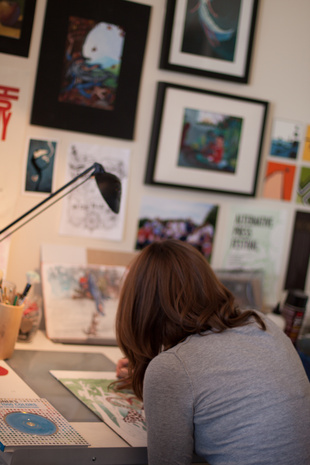
Several of the illustrations on your website seem to be references to fairy tales. What drew you towards this particular subject matter?
I was mostly interested in getting into the children’s book genre and felt that that subject matter was a good way to practice illustrating stories that kids would enjoy. Taking a well-known story and putting my own twist on it helped me stretch to see if I could expand a child’s mind. Books always did that for me as a kid, and I love how I could escape into a whole other world just by picking up a picture book. Also, most fairy tales are ridiculous stretches of the imagination, which my brain can relate to.
When did you begin to define yourself as an artist?
I defined myself as an artist very early on. I wanted to be one as long as I can remember, pretty much straight from the womb. My grandmother was a great artist along with a few of my sisters. Along with very supportive parents and friends, they always encouraged and indulged my creative tendencies. I have sketches from when I was really young and would always draw in class all over assignments, books, and worksheets. The stegosaurus was a common theme in elementary school, and then that grew to other fanciful creatures, giraffes most recently being a favorite. Being an artist has always been a big part of who I am and what I strive to become.
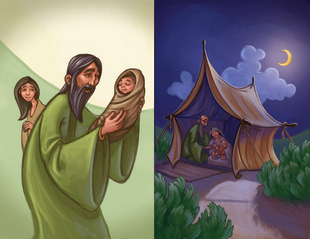
What have been some of your inspirations in your work?
Music is a big inspiration factor for me. I am always listening to something and I find that inspires the most creative juices to start flowing. Also, clever filmmaking, photography, and painting outside of my genre are things that feed me. I love art in all forms and like to saturate myself with it.
How have you been able to balance everyday concerns with artistic creativity?
Finding the balance of work and life with creative endeavors is a never-ending struggle. I work to keep as much structure in my life as possible so that stress is not getting in the way of being able to find inspiration. Also, keeping a vast supply of chocolate and Cary Grant movies on hand seems to calm any and all of my concerns. Everything is easier with chocolate. And everything is easier (especially on the eyes) with Cary Grant in the room.
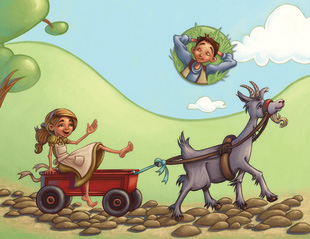
What’s your artistic process?
I begin in lots of different ways, gathering reference and information and inspiration from lots of various sources and then I just start sketching. I call it sketch vomit. Gross,
I know, but usually it takes a bunch of really bad ideas to get out of my head before I can grasp at any of the good ones. After they spill out all over my sketchbook, I can then narrow it down to something pretty. Then I take that idea, feed it, nurture it, sometimes sleep on it, and develop it until it produces wonderful idea children that are better and more beautiful versions of their parents. This usually involves lots of tracing paper or a light board. When I get to a final sketch I either scan it into the computer to be painted in Photoshop, or my favorite, I transfer it to a board and paint directly on top of it with acrylics. I will usually finish it off digitally or with some oil paints if I need a little extra push.
Somewhere in the middle there are explorations with color, which helps me pick a scheme, and also a value study to make sure the mood and lighting are just right. It looks really ugly until about the last 10% of the job. That’s when the magic happens and the illustration fairy comes in and tweaks it all. I pay her the big bucks.
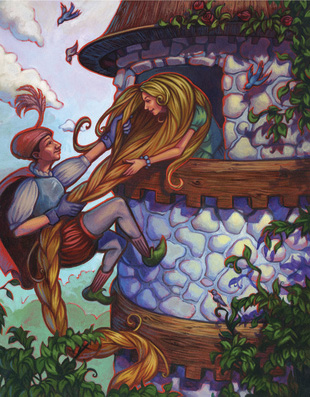
Could you explain what it felt like to sell your first design?
Glorious. Like eating mint choc chip ice cream right after riding my favorite rollercoaster. The best part was seeing the happy recipient’s joyful face. That is worth more than the money.
How has the gospel influenced your work?
Knowing the things I know, living the way I do, and making the constant decisions to try and align my life with God, influences every decision I make, especially the creative ones. I had a professor in college who taught me that everything I express through my art is connected somehow to me, and that in that expression I should strive to always define on the outside who I am on the inside. I believe that wholeheartedly.
I feel that being true to myself and my core beliefs is what I endeavor to show most in my artwork. I guess that just shows what a kid I am still at heart.
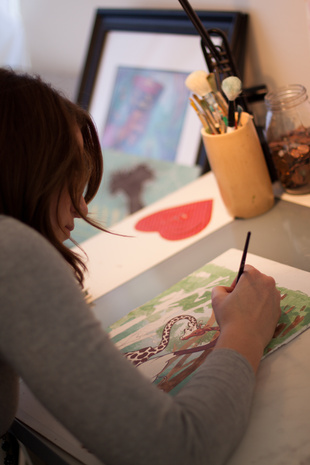
What other artists or paintings have inspired you?
I absolutely adore the golden age of illustration from the masters Norman Rockwell, J.C. Leyendecker, Howard Pyle, and N.C. Wyeth. Their ability to tell a story has always been inspiring to me. Also modern illustrators such as Jimmy Pickering, Robert Mackenzie, Jim Madsen, Guy Francis, Brandon Dorman, Dani Jones…the list could go on and on. I also have always loved John Singer Sargent for his ability to express just exactly the amount of information necessary with the minimal amount of brushstrokes. His work is beautiful.
How do you balance being Mormon and being an artist?
My beliefs in the gospel are parallel to many of my beliefs about the process of creation; therefore, I find the two weave throughout the core of my character. Being a Mormon and being an artist are intertwined as much as eating and sleeping into my life, so I find it incredibly simple to balance the two. In fact, if I didn’t have the inspiration and influence of the Spirit, I don’t think I would have nearly the amount of knowledge or motivation that I have. I attribute all those things to God.
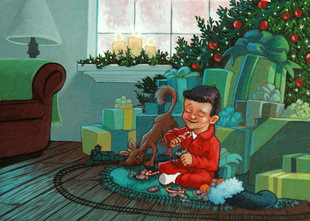
How do you see your art helping build the kingdom?
I use to plague myself with the question of why God has given me the desire, motivation, and drive to be a creating soul. Why, of all things to be blessed with, have I been given this? Is what I am doing really helping bring about his work or is this desire a selfish motivation of mine to pursue happiness?
It was a difficult question to answer. But then I decided that creating beautiful things has slowly become my way of glorifying God and giving back to Him in an aesthetic, albeit small way that I can. What I do is considered, by some, a frivolous or luxurious part of life—that art is not a required aspect but just something nice to have around. We aren’t doctors, teachers, or politicians, who have such an obvious effect on people and the world. We are, however, creators, which can have a tangible effect on the soul. I think that can sometimes be more important. A lot of my beliefs about God and the gospel are strengthened and reassured through art because I feel it brings a connection to Him that I cannot materialize in any other way. And if I can create that feeling for someone else, then I consider my life’s work successful and a good way to show God my devotion. ❧
